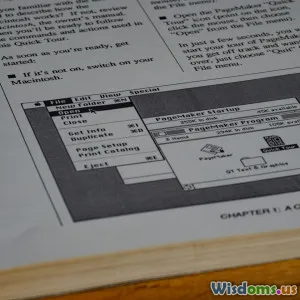
Is AI the Future of Technical Writing?
13 min read Explore how AI is transforming technical writing, its limitations, benefits, and what the future holds for this evolving discipline. (0 Reviews)
Is AI the Future of Technical Writing?
In 2024, the realm of technical writing faces one of its greatest revolutions yet: the inexorable rise of Artificial Intelligence (AI). We have grown accustomed to concise tutorials, lucid API documentation, and clearly structured user manuals crafted by seasoned technical writers. Yet, the shimmering promise of AI—automated drafting, real-time updates, personalized documentation, and seamless translation—looms large over the industry.
Is AI poised to reshape technical writing or simply augment what already exists? Let’s venture beyond the buzzwords and explore the true role of AI in the future of technical communication.
The State of Technical Writing: Tradition Meets Technology
Technical writing is an indispensable foundation of our digital era. Whether you’re assembling an exercise bike, configuring complex software, or troubleshooting network hardware, you rely on well-written documentation. Traditionally, expert communicators meticulously construct such materials, balancing clarity, detail, and accessibility.
Historically, the process involves:
- Deep subject-matter research
- Interviews with engineers or designers
- Drafting, editing, and reviewing
- Localization for different markets
- Maintenance and updates
Despite the immense value it provides, technical writing is under constant pressure. The rapid pace of technological change, growing user diversity, and localization demands challenge even the most skilled professionals. As a result, businesses are increasingly seeking ways to make the documentation process:
- More efficient
- Highly adaptive to new product releases
- Accessible to global and non-English-speaking audiences
Enter: AI.
How AI is Already Transforming Technical Writing
AI is not a distant vision for technical writing—it’s changing the landscape today. Here’s how:
1. Automated Drafting and Content Generation
AI-powered language models like OpenAI’s GPT-4, Google’s PaLM, and giant custom models from enterprises are now capable of drafting clear, coherent technical content. For instance, AI can generate entity definitions, step-by-step guides, or API reference entries in a fraction of the time compared to a human.
Case Example:
- GitHub Copilot, launched in 2021, not only suggests code but also proposes documentation snippets and comments as developers write code. Many organizations now use linguistic models integrated into content management systems to draft initial versions of technical articles.
Impact: AI accelerates the first-draft process and gives writers a solid starting point, reducing repetitive manual work and increasing overall efficiency.
2. Intelligent Content Updates
Product features, UIs, and APIs are updated continuously in tech industries. AI models integrated with platform development pipelines can scan codebases, documentation, and update respective manuals or help centers.
Real-World Insight:
- Salesforce combines AI with automatic detection of API changes to propose and implement documentation updates that might otherwise be missed, dramatically reducing maintenance backlog.
3. Personalized Documentation
Modern documentation must address users of varying skill levels, backgrounds, and contexts. AI enables dynamic generation of help content tailored precisely to individual user needs.
For Example:
- Zendesk’s Answer Bot uses AI to suggest context-specific articles based on user queries.
- Large SaaS applications now deploy AI-driven knowledge bases that adapt FAQ contents based on regional, role-based, or usage-pattern data.
4. Language Localization and Accessibility
Localization and accessibility remain resource-intensive. AI not only translates technical content into multiple languages via neural machine translation (NMT), but can also check for cultural appropriateness, plain language, and accessibility compliance.
Industry Note:
- Adobe accelerated its documentation translation cycle by integrating NMT, freeing human linguists for nuanced language and factual checks rather than first-pass translations.
Limitations and Risks: Where AI Still Needs Help
While AI’s role is expanding rapidly, it’s crucial to understand its present-day limitations—and their ramifications.
1. Technical Depth Beyond Syntax
Raw AI can effectively churn out API specs or rote instructions, but struggles in domains requiring:
- Nuanced technical understanding
- Sequence logic based on context
- Decision/inference around ambiguity or missing information
Quote:
"AI is an outstanding writing assistant, but the strategic decisions—like what NOT to say, or how to resolve ambiguity—still require a human in the loop." — Dr. Sarah Chong, Lead Information Architect, IBM
2. Maintaining Trust and Tone
Technical writing isn’t only about correctness—it’s about trust and empathy. Documentation has to reassure, motivate, and sometimes gently warn. AI-generated text often lacks the voice, consistency, and context-sensitive judgment that reassure users and reflect an organization’s ethos.
3. Misinformation and Hallucination
AI models can generate ‘plausible’ text that sounds right but contains subtle, damaging errors—a phenomenon known as “AI hallucination.” If a user follows incorrect instructions generated by AI, the cost could be great, especially in regulated domains like medicine or aviation.
Example:
- In 2022, an experiment by a telecom provider let AI generate support diagrams for network troubleshooting. Subtle misstatements in alternative step recommendations led to widespread customer confusion, requiring manual document revision and public clarification.
4. Security and Confidentiality Concerns
AI-powered documentation must tread carefully around proprietary code and undisclosed system details. Generating and summarizing sensitive specifications carries the risk of leaking trade secrets if models train on confidential information.
5. Ethical and Legal Implications
Questions around intellectual property, legal responsibility for content errors, and regulatory compliance have yet to be thoroughly resolved with AI-generated docs—especially in globally regulated sectors.
AI and the Human Writer: A Synergistic Model
Most reporting on “AI takeover scenarios” falls into a common trap: presenting human experts and AI as oppositional. Reality suggests a burgeoning partnership instead.
Human Writers: The Architects, Not Just the Builders
Expert technical communicators do far more than arrange words:
- They determine the goals of documentation
- Curate which concepts receive depth and which are referenced
- Specify reader personas, anticipated skill levels, cultural context, and accessibility needs
AI in this framework is a tireless researcher, outliner, and editor—but architects must set vision and evaluate output.
AI: The Power Tool for Writers
When harnessed appropriately, AI enables human writers to:
- Beat tight documentation deadlines with automated first drafts
- Focus on high-level organization, user feedback cycles, and quality control
- Spend more time with subject-matter experts extracting unique insights
Real-World Perspective:
- Microsoft’s Azure Docs Team: By integrating AI-driven topic card generation and code sample detection, the team claims a 40% reduction in time spent on initial documentation, allowing writers to enhance strategic narrative and educational goals.
Continuous Learning: Human Oversight Brings Reliability
Each AI recommendation is reviewed, curated, or modified. Feedback from experienced writers also sharpens AI’s future output—a learning loop.
Hybrid Authoring in Action:
- AI generates a new troubleshooting guide
- Human technical writer refines ambiguous instructions, adds context gleaned from beta testers, and aligns voice with documentation standards
- Final document is quality-checked for compliance, tone, and clarity
Practical Applications: AI-Driven Technical Writing Tools
Popular Tools Elevating Tech Writing:
- Grammarly and Quillbot: AI-powered suggestions for grammar, clarity, and paraphrasing
- MadCap Flare: Includes AI modules for content reuse, translation suggestions, and topic linking
- Document360 & HelpDocs: AI-driven search and article suggestion features, improving help desk support and onboarding
Emerging Trends:
- Knowledge Graph Integration: Structuring technical knowledge so that AI models retrieve relevant granular concepts rather than generating text freely
- Voice-Activated Documentation: AI chatbots and voice assistants deliver technical instructions through spoken language for hands-free scenarios (e.g., field repairs)
- Visual-AI Pairings: Combining AI writing with automatic diagram or screenshot generation for end-to-end documentation packs
Will AI Replace Technical Writers?
The economic rationale to “replace” human writers seems inexorable at first glance, but the reality is nuanced.
1. The Demand for Depth and Human Judgment
Complex products, especially those with safety implications or sophisticated workflows, will always require writers with hands-on experience and domain understanding. Only a human can intuit potential user frustrations, empathize in troubleshooting scenarios, and anticipate information gaps.
2. Quality Reliance on Human Oversight
AI can offer consistency at scale, but any lapse in curation threatens trust. Technical documentation is not just an afterthought—it’s a core customer experience pillar. A blend of human editorial authority and AI-driven efficiency is the most futureproof model.
3. Expanding, Not Shrinking, the Role
Rather than diminishing the profession, AI frees technical communicators to:
- Lead documentation strategy
- Experiment with novel content types and delivery platforms
- Collaborate with UX, support, and engineering on lifecycle documentation needs
“AI can handle the pattern-based grunt work, but creativity, empathy, and strategic vision remain intensely human.”—Cate Miller, Documentation Lead, Atlassian
This echoes past technology introductions: rather than eradicate, typewriters and software broadened what ‘writers’ could achieve—not replaced them.
What Lies Ahead: The Future of AI in Technical Writing
1. Hyper-Personalized, Contextual Documentation
Imagine documentation portals that adapt in real-time:
- Delivering executable code based on a customer’s API subscription level
- Skipping basic explanations for expert users
- Merging documentation with live analytics to clarify commonly misunderstood features instantly
2. Multimodal Documentation
We’re moving towards technical content generated not just as text, but dynamically converted to:
- Interactive walkthroughs
- Video scripts auto-illustrated by AI
- Augmented reality repair guides delivered by wearable devices
3. Real-time Collaboration and Feedback Loops
AI-driven writing tools can triage user feedback instantly, highlight ambiguous steps, and suggest content improvements based on real-world queries, closing the documentation-to-user-need gap.
4. Regulatory and Ethical Standards for AI Authorship
As AI becomes commonplace, tech companies and regulators will codify standards:
- Labeling AI-generated documentation
- Strict review cycles for high-stakes materials
- Improved transparency over data sources and AI decision-making
Conclusion: The Future is Collaborative
AI is undeniably transforming technical writing. Its strengths—automation, rapid revision, language adaptation, and data-driven insights—elevate the profession to new heights. Yet, the fundamentals of excellent documentation—clarity, empathy, deep user understanding, and trust—are products of human intention and creativity.
Rather than view AI as a “replacement,” we should embrace it as a force multiplier for technical communicators. The future belongs to those who can harness AI’s power to enhance and inspire, curating materials that meet users precisely where they are. As technology continues its relentless march forward, so too does the craft of technical writing—augmented, but never replaced, by the transformative force of artificial intelligence.
Rate the Post
User Reviews
Popular Posts



















